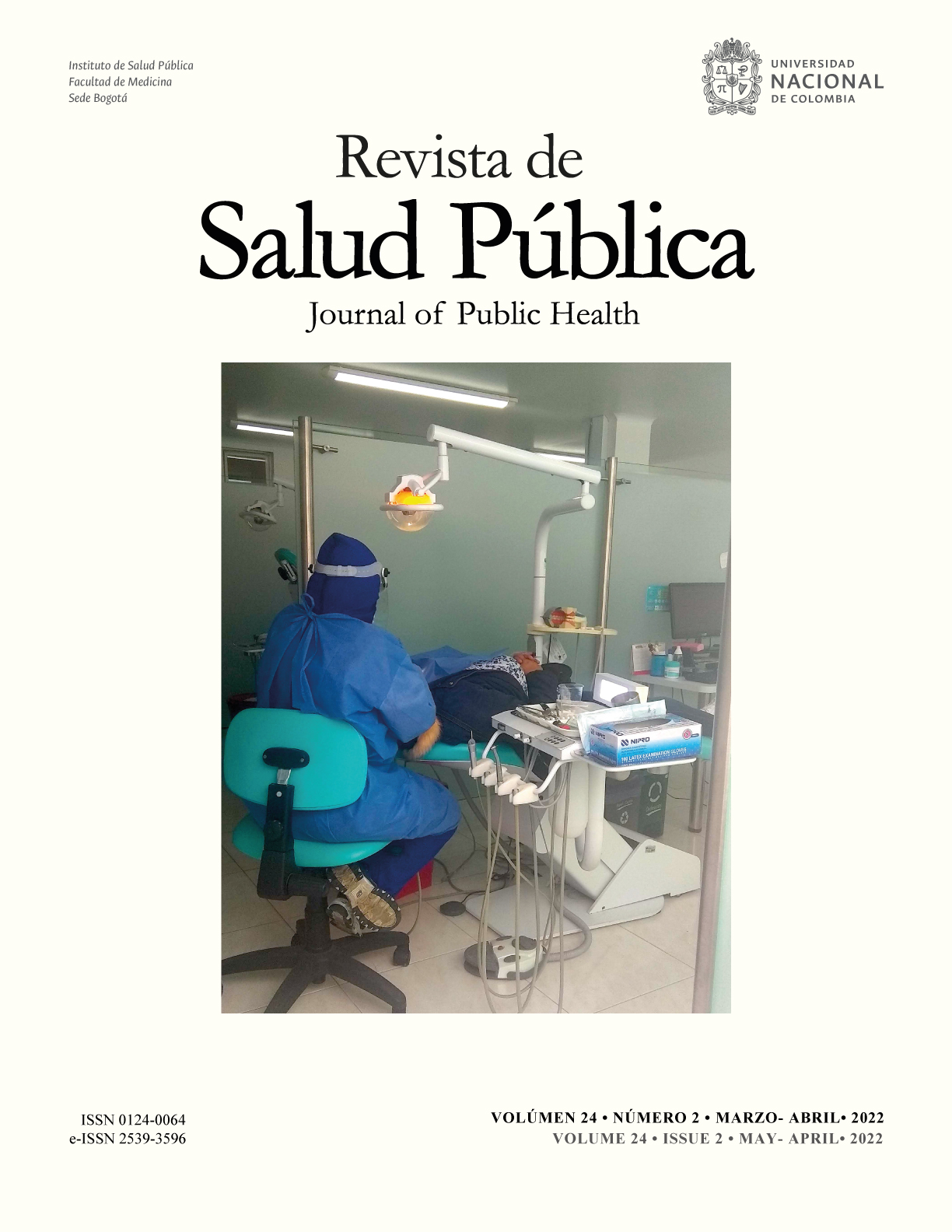Intención de vacunarse contra COVID-19 en la población de 40 años en adelante en México
Intention to be vaccinated against COVID-19 in the population of 40 years and older in Mexico
DOI:
https://doi.org/10.15446/rsap.v24n2.96015Palabras clave:
Programas de inmunización, negativa a la vacunación, vacunación masiva, percepción social, medios de comunicación, conducta en la búsqueda de información (es)Immunization programs, vaccination refusal, mass vaccination, social percepction, communications media, information seeking behavior (en)
Descargas
Objetivo Evaluar el efecto de las fuentes de información sobre COVID-19, los beneficios y las barreras percibidas de la vacunación, y la actitud hacia la vacunación sobre la intención de vacunarse contra COVID-19 en la población de 40 años en adelante en México.
Métodos Se desarrolló una investigación cuantitativa, transversal y explicativa. Se aplicó una encuesta electrónica a 703 personas de 40 años en adelante que residen en México. El análisis de resultados se realizó a través de la técnica de ecuaciones estructurales por medio del método de mínimos cuadrados parciales.
Resultados Las fuentes de información sobre COVID-19 influyen positivamente sobre los beneficios percibidos de la vacuna y disminuyen las barreras percibidas. Además, los beneficios percibidos influyen positivamente sobre la actitud hacia la vacunación de COVID-19; sin embargo, las barreras no afectan la actitud. Adicionalmente, esta última influye en la intención a vacunarse contra COVID-19 e indirectamente las fuentes de información y los beneficios percibidos influyen sobre la intención a vacunarse mediados por la actitud.
Objective To evaluate the effect of information sources on COVID-19, the benefits and perceived barriers of vaccination, and the attitude towards vaccination on the intention to get vaccinated against COVID-19 in the population aged 40 and over in Mexico.
Methods A quantitative, cross-sectional and explanatory investigation was developed. An electronic survey was applied to 703 people aged 40 and over who reside in Mexico. The analysis of results was carried out through the technique of structural equations by means of the method of partial least squares.
Results The sources of information on COVID-19 positively influence the perceived benefits of the vaccine and reduce the perceived barriers. Furthermore, the perceived benefits positively influence the attitude towards COVID-19 vaccination; however, barriers do not affect attitude. Additionally, the latter influences the intention to be vaccinated against COVID-19 and indirectly the sources of information and the perceived benefits influence the intention to be vaccinated mediated by the attitude.
Referencias
Andre FE, Booy R, Bock HL, Clemens J, Datta SK, John TJ, et al. Vac- cination greatly reduces disease, disability, death and inequity worldwide. B World Health Organ. 2008; 86:140-6. https://doi.org/10.2471/blt.07.040089. DOI: https://doi.org/10.2471/BLT.07.040089
Cavazos-Arroyo J, de Celis-Herrero CP. Severidad, susceptibilidad y normas sociales percibidas como antecedentes de la intención de vacunarse contra COVID-19. Rev. Salud Publica (Bogotá). 2020; 22(2): 1-7. https://doi.org/10.15446/rsap.v22n2.86877. DOI: https://doi.org/10.15446/rsap.v22n2.86877
Herrera-Añazco P, Uyen-Cateriano A, Urrunaga-Pastor D, Bendezu-Quispe G, Toro-Huamanchumo CJ, Rodriguez-Morales AJ, Hernandez AV, Benites-Zapata VA. Prevalencia y factores asociados a la in- tención de vacunación contra la COVID-19 en el Perú [Preprint]. 2021; 1-17. https://doi.org/10.1590/SciELOPreprints.1879. DOI: https://doi.org/10.1590/SciELOPreprints.1879
Sherman SM, Smith LE, Sim J, Amlôt R, Cutts M, Dasch H, Rubin GJ, Sevdalis N. COVID-19 vaccination intention in the UK: results from the COVID-19 vaccination acceptability study (CoVAccS), a nationally representative cross-sectional survey. Hum. Vaccines Immunother. 2020; 1-10. https://doi.org/10.1080/21645515.2020.1846397. DOI: https://doi.org/10.1101/2020.08.13.20174045
Hwang J. Health Information Sources and the Influenza Vaccination: The Mediating Roles of Perceived Vaccine Efficacy and Safety. J Health Commun. 2020; 25(9):727-35. https://doi.org/10.1080/10810730.2020.1840675. DOI: https://doi.org/10.1080/10810730.2020.1840675
Lee HO, Kim S. Linking health information seeking to behavioral outcomes: Antecedents and outcomes of childhood vaccination information seeking in South Korea. J Health Commun. 2015; 20:285-96. https://doi.org/10.1080/10810730.2014.927035. DOI: https://doi.org/10.1080/10810730.2014.927035
Ahmed N, Quinn SC, Hancock GR, Freimuth VS, Jamison A. Social media use and influenza vaccine uptake among White and African American adults. Vaccine. 2018; 36(49):7556-61. https://doi.org/10.1016/j.vaccine.2018.10.049. DOI: https://doi.org/10.1016/j.vaccine.2018.10.049
Smith LE, Amlôt R, Weinman J, Yiend J, Rubin GJ. A systematic review of factors affecting vaccine uptake in young children. Vaccine. 2017; 35(45):6059-69. https://doi.org/10.1016/j.vaccine.2017.09.046. DOI: https://doi.org/10.1016/j.vaccine.2017.09.046
Stecula DA, Kuru O, Jamieson KH. How trust in experts and media use affect acceptance of common anti-vaccination claims. HKS Misinf Rev. 2020; 1:1-5. https://doi.org/10.37016/mr-2020-007. DOI: https://doi.org/10.37016/mr-2020-007
Zhao E, Wu Q, Crimmins EM, Ailshire JA. Media trust and infection mitigating behaviours during the COVID-19 pandemic in the USA. BMJ Global Health. 2020; 5(10):e003323. https://doi.org/10.1136/bmjgh-2020-003323. DOI: https://doi.org/10.1136/bmjgh-2020-003323
Hwang J, Shah DV. Health information sources, perceived vaccination benefits, and maintenance of childhood vaccination schedules. J. Health Commun. 2019; 34(11):1279-88. https://doi.org/10.1080/10410236.2018.1481707. DOI: https://doi.org/10.1080/10410236.2018.1481707
Kamali S, Ahmadian L, Khajouei R, Bahaadinbeigy K. Health information needs of pregnant women: information sources, motives and barriers. Health Inf Libr J. 2018; 35(1):24-37. https://doi.org/10.1111/hir.12200. DOI: https://doi.org/10.1111/hir.12200
Poelaert D, Pereira P, Gardner R, Standaert B, Benninghoff B. A review of recommendations for rotavirus vaccination in Europe: arguments for change. Vaccine. 2018; 36(17):2243-53. https://doi.org/10.1016/j.vaccine.2018.02.080. DOI: https://doi.org/10.1016/j.vaccine.2018.02.080
Tate J, Aguado T, De Belie J, Holt D, Karafillakis E, Larson HJ, Larsone S, Nyef D, Salisbury M, Vottah S, Wait S. The life-course approach to vaccination: Harnessing the benefits of vaccination throughout life. Vaccine. 2019; 37(44):6581-3. https://doi.org/10.1016/j.vaccine.2019.09.016. DOI: https://doi.org/10.1016/j.vaccine.2019.09.016
Maurer J, Uscher-Pines L, Harris KM. Perceived seriousness of seaso- nal and A (H1N1) influenzas, attitudes toward vaccination, and vaccine uptake among U.S. adults: Does the source of information matter? Prev Med (Baltim). 2010; 51(2):185-7. https://doi.org/10.1016/j.ypmed.2010.05.008. DOI: https://doi.org/10.1016/j.ypmed.2010.05.008
Rosen BL, Goodson P, Thompson B, Wilson KL. School nurses' knowledge, attitudes, perceptions of role as opinion leader, and professional practice regarding human papillomavirus vaccine for youth. J. Sch. Health. 2015; 85(2):73-81. https://doi.org/10.1111/josh.12229. DOI: https://doi.org/10.1111/josh.12229
Saied SM, Saied EM, Kabbash IA, Abdo SAEF. Vaccine hesitancy: Beliefs and barriers associated with COVID-19 vaccination among Egyptian medical students [Preprint]. J. Med. Virol. 2021. https://doi.org/10.1002/jmv.26910. DOI: https://doi.org/10.1002/jmv.26910
Williams L, Gallant AJ, Rasmussen S, Brown Nicholls LA, Cogan N, Deakin K, et al. Towards intervention development to increase the uptake of COVID-19 vaccination among those at high risk: Outlining evidence-based and theoretically informed future intervention content. Br. J. Health Psychol. 2020; 25(4):1039-54. https://doi.org/10.1111/bjhp.12468. DOI: https://doi.org/10.1111/bjhp.12468
Houseman C, Butterfoss FD, Morrow AL, Rosenthal J. Focus groups among public, military, and private sector mothers: insights to improve the immunization process. Public Health Nurs. 1997;14(4):235-43. DOI: https://doi.org/10.1111/j.1525-1446.1997.tb00296.x
Ajzen I. The theory of planned behavior. Organizational behavior and human decision processes. 1991; 50(2):179-211. https://doi.org/10.1016/0749-5978(91)90020-T. DOI: https://doi.org/10.1016/0749-5978(91)90020-T
Paul E, Steptoe A, Fancourt D. Attitudes towards vaccines and intention to vaccinate against COVID-19: Implications for public health communications. The Lancet Reg Health-Europe. 2021; 1:100012. https://doi.org/10.1016/j.lanepe.2020.100012. DOI: https://doi.org/10.1016/j.lanepe.2020.100012
Ruiz JB, Bell RA. Predictors of intention to vaccinate against COVID-19: Results of a nationwide survey. Vaccine. 2021; 39(7):1080-6. https://doi.org/10.1016/j.vaccine.2021.01.010. DOI: https://doi.org/10.1016/j.vaccine.2021.01.010
Gobierno de México. Política nacional de vacunación contra el virus SARS-COV-2 para la prevención de la COVID-19 en México. Ciudad de México; 2020.
Degarege A, Krupp K, Fennie K, Srinivas V, Li T, Stephens DP, Mad- hivanan P. An integrative behavior theory derived model to assess factors affecting HPV vaccine acceptance using structural equation modeling. Vaccine. 2019; 37(7):945-55. https://doi.org/10.1016/j.vaccine.2019.01.012. DOI: https://doi.org/10.1016/j.vaccine.2019.01.012
Askelson NM, Campo S, Lowe JB, Smith S, Dennis LK, Andsager J. Using the theory of planned behavior to predict mothers’ intentions to vaccinate their daughters against HPV. J Sch Nurs. 2010; 26(3):194-202. DOI: https://doi.org/10.1177/1059840510366022
Harmsen IA, Lambooij MS, Ruiter RA, Mollema L, Veldwijk J, van Weert YJ, et al. Psychosocial determinants of parents’ intention to vaccinate their newborn child against hepatitis B. Vaccine. 2012; 30(32):47717. https://doi.org/10.1016/j.vaccine.2012.05.034. DOI: https://doi.org/10.1016/j.vaccine.2012.05.034
Martin LR, Petrie KJ. Understanding the dimensions of anti-vaccination attitudes: The vaccination attitudes examination (VAX) scale. Annals of Behavioral Medicine. 2017; 51(5):652-60. https://doi.org/10.1007/s12160-017-9888-y. DOI: https://doi.org/10.1007/s12160-017-9888-y
Hair JF, Black WC, Babin BJ, Anderson RE. Multivariate Data Analysis. 7th Edition. New York: Pearson; 2010.
Hair J, Hult G, Ringle C, Sarstedt M. A Primer on Partial Least Square Structural Equation Modeling (PLS-SEM). California: Sage; 2017.
Cómo citar
APA
ACM
ACS
ABNT
Chicago
Harvard
IEEE
MLA
Turabian
Vancouver
Descargar cita
Licencia

Esta obra está bajo una licencia internacional Creative Commons Atribución 4.0.
Esta revista provee acceso libre inmediato a su contenido bajo el principio de que hacer disponible gratuitamente investigación al publico apoya a un mayor intercambio de conocimiento global.
Todos los contenidos de esta revista, excepto dónde está identificado, están publicados bajo una Licencia Creative Commons Atribución 4.0.




















